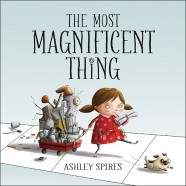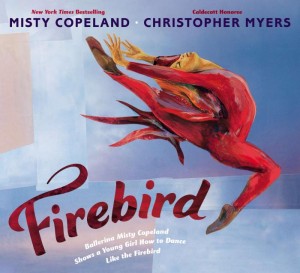27 Books You Can Use This Year
During the “Moving Beyond the Basics… Reaching for More” conference on Aug. 11 at the Byron Center High School in Michigan, a roomful of teachers and I read through boxes of books. (Thank you, Annemarie Johnson and Kate DiMeo, for inviting me to share informational picture books and to talk about kids’ book publishing.) ((Have I mentioned that my first picture book, GROUNDHOG’S DILEMMA, will come out this December 1 from Charlesbridge?)) After browsing and brainstorming, we generated a list of 27 books with lesson ideas we can use this year in kindergarten through third grade. Feel free to share it!
| Title | Author | Illustrator | Lesson Ideas |
| Alphabeasties and Other Amazing Types | Werner Sharon | Forss, Sarah | alliteration, identifying letters in different fonts – visual learners |
| Aunt Ant Leaves through the Leaves | Coffelt, Nancy | homonyms/homophones | |
| Bee Dance | Chrustowski,Rick | vocabulary, informational reading, chronological text structure, debate if it is “narrative” or “informative” | |
| The Best of Times | Tang, Greg | Briggs, Harry | multiplication in third grade, rules for each and tables |
| Boy, Were We Wrong About the Weather! | Kudlinkski, Kathleen V. | Serra, Sebastia | compare/contrast what we once thought to what we now think, text features, weather in first grade, landforms in second |
| Families | Rotner, Shelley | Rotner, Shelley | “all about” writing at a simple level = great mentor text |
| Greedy Apostrophe: a cautionary tale | Carr, Jan | Long, Ethan | grammar – ways to use an apostrophe |
| Henry’s Map | Elliot, David | mapping skills lesson, pictures with labels = text feature, mentor tex for writing | |
| How To Surprise a Dad | Reagan, Jean | Wildish, Lee | mentor text for “how to” writing that goes beyond basic instruction format, mentor text for incorporating all five senses in details |
| In Mary’s Garden | Kugler, Carson | Kugler, Tina | compare/contrast with “The Most Magnificient Thing” |
| The King Who Rained | Gwynne, Fred | homonyms/homophones/word play, figurative language | |
| Lucky and Stu vs. the Mikanikal Man | Van Wright, Cornelius | reading for pleasure! Friendship themes and good “boy” book | |
| Math Fables | Tang, Greg | Cahoon, Heather | number sense for youngers |
| Me, Too! | Dunklee, Annika | Smith, Lori Joy | opinion writing: “Reason #1”, friendship story to discuss |
| Messy Jesse | Bowles, Paula | writing prompt, “what I’m good at”, punctuation lesson | |
| Nino Wrestles the World | Morales, Yuyi | using context to decode unfamiliar words, appreciation of other languages/cultures | |
| One Boy | Seeger, Laura Vaccaro | finding words within words | |
| One Word from Sophia | Averbeck, Jim | Ismail, Yasmeen | persuasive writing, writing for an audience, text features like glossary |
| Ostriches Are Not Pets! | Niver, Heather Moore | persuasive writing | |
| Over in the Wetlands | Rose, Caroline Starr | Dunlavey, Rob | vocabulary – word choice and author’s craft, context clues, inferring, how do animals prepare for storms compared to how people prepare? |
| Rufus Goes to School | Griswell, Kim T. | Gorbachev, Valeri | use at the beginning of the school year, shows importance of learning how to read, point out persuasive reasons why pigs should (not) go to school |
| Simple Machines | Adler, David A. | Raff, Anna | use as a mentor text for flip books, compare/contrast, nonfiction with illustrations and not photos, text features, easy nonfiction that’s not about animals |
| Speed, Speed, Centipede! | Dahl, Michael | Trover, Zachary | early math counting by tens, shows 10 frames |
| This Plus That: Life’s Little Equations | Rosenthal, Amy Krouse | Corace, Jen | writing with math symbols |
| Water is Water | Paul, Miranda | Chin, Jason | “show, don’t tell”, art tells story as much as text does |
| Wumbers | Rosenthal, Amy Krouse | Lictenheld, Tom | lesson on speech bubbles |
| Zero the Hero | Holub, Joan | Lictenheld, Tom | higher math concepts, friendship, lesson on speech bubbles |
The Most Magnificent Thing
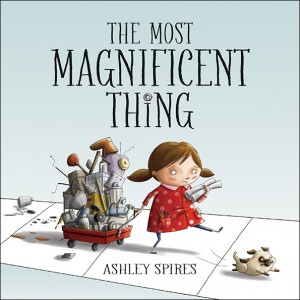 The perfectionist in me was upset to have missed posting last month, so as a reminder to be more patient with myself, I pulled out the very wise, very magnificent book, The Most Magnificent Thing by Ashley Spires.
The perfectionist in me was upset to have missed posting last month, so as a reminder to be more patient with myself, I pulled out the very wise, very magnificent book, The Most Magnificent Thing by Ashley Spires.
The unnamed girl has an idea for a magnificent thing. She uses all kinds of cool tools like hammers, screwdrivers and wrenches (rock on, tool girl) but she just can’t make in reality the fabulous idea in her head. She works and reworks it, but “(h)er hands feel too BIG to work, and her brain is too full of all the not-right things.” So many kiddos can relate to this feeling, and to the ensuing meltdown. Her assistant (her dog) suggests she take a walk, where the girl gets a break and a bit of perspective. In the end, she’s able to see that a part of her original creation can be reworked into a wholly new, magnificent thing. LOVE!
This is a wonderful book to share at the beginning of next school year. You and your students can discuss the universal feelings of frustration during the creative process, comment on how the girl worked through her angst, and come up with ways you can handle it in your classroom (your Self Smart kids excelling with Key Ideas and Details? Score!) Then, get out recycled stuff like paper towel tubes and fun art stuff like pipe cleaners and challenge your kiddos to build their own most magnificent thing. Kids can write and draw plans before building, and write descriptions of what they’ve made at the end. (What is that, exactly? It’s magnificent!) Assisting others and taking breaks are encouraged as part of the process.
Bringing tools like screwdrivers into the classroom can be tricky, but one successful way to do it is to have a “take apart” center. Ask for donations of broken electronics and small tools, or scour your local thrift shops. It’s great for fine motor skills to unscrew those little screws, and examining the inner workings of an old alarm clock is real-life science!
I have a really exciting reason for why I missed May’s post, and I’m glad the ink is on the contract so I can share it with everyone now: along with my picture book, GROUNDHOG’S DILEMMA, my second book will be published in December, 2015, too! DRAW WITH A VENGEANCE is a grown-up book, and since it comes from my snarky side, I’m using a pseudonym – Helen Wrath. For those of you kid-lit lovers who enjoy a bit of dark humor, I hope you’ll check it out!
Read MoreThe Poetry of Firebird
Because poetry doesn’t have to rhyme, because poetry can tell a story, because the best poetry lights sparks of hope inside of us – this is my choice for April’s Month of Poetry.
Firebird is written by Misty Copeland and illustrated by Christopher Myers. A little girl sees ballet soloist Misty Copeland and thinks “the space between you and me/ is longer than forever”. Misty lets the girl know that with hard work and dedication “we’ll make the night sky our starry curtain/ the moon our silver spotlight/ as we spin across the planets/ pirouetting tightly as the curls on our heads”. Misty Copeland is the second African American soloist in the history of the American Ballet Theater, and her uplifting poem-story is perfectly enhanced by Christopher Myers’ gorgeous art.
The poem is written in two voices – the little girl and Misty Copeland. After you share this book for the sheer pleasure of it, talk about the voices of the poem. (You’ll be rockin’ Craft & Structure as well as Range of Reading.) It can be read as literally two people, or we can see it metaphorically, as if the young girl is talking to her future self or as if Misty is talking to her past, younger self. Encourage your students to write poems where they can write as their “today” selves talking to themselves in the future or the past. Because poetry is meant to be shared aloud, hold a poetry slam where students can read their poems aloud, taking on both parts or asking a friend to read a voice. Who knows what future dancers, scientists, and presidents may come to life in your classroom?
Also, if you’re on the lookout for an Orthodox Easter book (which will be celebrated this Sunday), I recommend Catherine’s Pascha: A Celebration of Easter in the Orthodox Church written by Charlotte Riggle and illustrated by R.J. Hughes. For those who celebrate Passover, Easter, and/or the coming of Spring, I wish you all joy and a sense of hopeful renewal!
Read More
Go, Shapes, Go!
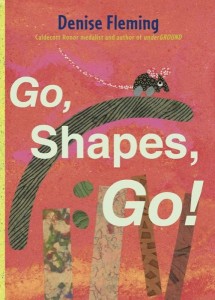 One of my favorite ways to hook readers during March is Reading Month is to do an author study, and one of my all-time favorite author/illustrators for the elementary crowd is Denise Fleming.
One of my favorite ways to hook readers during March is Reading Month is to do an author study, and one of my all-time favorite author/illustrators for the elementary crowd is Denise Fleming.
I’ve had a book crush on Fleming since 1991 when I first read In the Tall, Tall Grass. The richness of the colors, the text that is so precise and still so simple – it draws in young readers who ask for it over and over. Fleming’s latest book, Go, Shapes, Go! again takes simple but descriptive words and art, and asks kids to play along. It’s brilliant.
A mouse tells recognizable shapes (square, rectangle, triangle, oval, arc) to move to combine into a character. Verbs like bounce, slither, and twirl along with the shapes that are labeled on each page make for the perfect opportunity to build vocabulary while supporting early readers. (Go, Craft & Structure, Go!) The plot of how the shapes combine and recombine to the delight (or dismay) of the mouse makes this book more than just a “name the shape” book.
Denise Fleming’s website is packed with fun stuff for kids to go along with her books. You can print off the shapes she used in Go, Shapes, Go! for kids to move and make their own characters, and there’s a Shapes Match-Up page so kids can match the labeled shape with the word describing how it moved in the book
The process of pulp painting that Fleming uses to make her picture book art is fascinating. Click through denisefleming.com or go to YouTube to see videos of how Fleming colors the cotton rag fiber, makes the stencils, and pours the slurry through a screen. She even has in-depth directions to make paper yourself, and a much easier version using toilet paper – a guaranteed hit for kids!
This March, share Go, Shapes, Go! and compare it with Fleming’s 20+ other wonderful picture books for preschoolers and early elementary students. After you’ve all fallen in love with her work, email Denise through her website. She is an exceptional person as well as an amazing author/illustrator, and your kids will have a whole new appreciation for books after getting to know her.
Read MoreThe winner is: You Are (Not) Small!
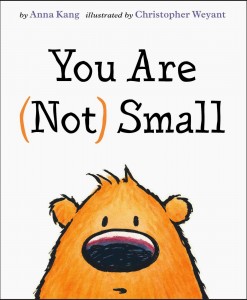 Happy Book Award Season! Many of us look forward to the annual announcement of the Caldecott and Newbery Medal Awards from the American Library Association, but the one that made me hoot and holler loudest this year was the announcement of the winner of the Theodor Seuss Geisel Award for the most distinguished beginning reader book: You Are (Not) Small written by Anna Kang and illustrated by Christopher Weyent.
Happy Book Award Season! Many of us look forward to the annual announcement of the Caldecott and Newbery Medal Awards from the American Library Association, but the one that made me hoot and holler loudest this year was the announcement of the winner of the Theodor Seuss Geisel Award for the most distinguished beginning reader book: You Are (Not) Small written by Anna Kang and illustrated by Christopher Weyent.
Fantastic “easy” reader? Check.
Great for Readers’ Theater? Check.
Funny ending? Check.
Works for a ton of tie-in lessons? Check.
Story and art that kids will want to return to again and again? Big ol’ check!
Finding mentor texts on expressing opinion, giving reasons, persuasion, etc. isn’t easy for the younger crowd, so if you teach kindergarten – third grade, grab You Are (Not) Small. (It’s also fantastic for a print concepts lesson on italics, ellipses, underlining, for a lesson on reading with expression, for a math/science tie-in for comparing items by size, but I digress.)
The two main characters in this book express clear, opposite opinions. The orange fuzzy creature tells the purple fuzzy creature, “You are small.” The purple fuzzy disagrees, “I am not small. You are big.” Back and forth they go, giving reasons for their opinion by comparing themselves to other fuzzy creatures. It’s so simple it’s brilliant, and the ending will get everyone giggling.
After reading this to a first grade class, I told them, “You are small.” Uproar ensued. “No, we aren’t!”
“Yes, my opinion is that you are small, and my reason is that you are all smaller than this bookshelf.”
“But we’re bigger than the chair!” “Yes, and we’re taller than the desk!”
This led to an easy quick-write session: choose an opinion statement of “I am big” or “I am small” and write three reasons to support your opinion. Go!
So grab You Are (Not) Small by Anna Kang and Christopher Weyant, and check out other winners of the Theodor Seuss Geisel Award. The Caldecott and Newbery Medals are wonderful, but they aren’t the only awards given by ALA, so explore lists like the Coretta Scott King Awards and treat yourself to award-winning books.
Read More
The Cybils 2014 Finalists for Fiction Picture Books
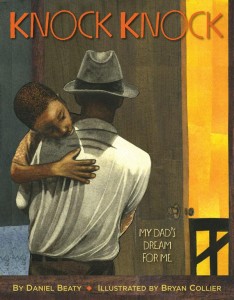 I was honored to be a first round judge for the 2014 Cybils Awards in the fiction picture book category. I was one of seven people who volunteered to read more than 229 picture books and to argue for the books we thought were outstanding. The reading part was easy. Debating the merits of books I love with other well-read, highly intelligent, articulate bloggers – way tougher than I thought. Some books that I adored didn’t click with other readers, and some of their favorites I didn’t like. The process again reminded me of how personal our connection with books is, and why we need such a wide variety in our libraries.
I was honored to be a first round judge for the 2014 Cybils Awards in the fiction picture book category. I was one of seven people who volunteered to read more than 229 picture books and to argue for the books we thought were outstanding. The reading part was easy. Debating the merits of books I love with other well-read, highly intelligent, articulate bloggers – way tougher than I thought. Some books that I adored didn’t click with other readers, and some of their favorites I didn’t like. The process again reminded me of how personal our connection with books is, and why we need such a wide variety in our libraries.
In the end, we were able to choose seven fiction picture books to move on to Round 2. Good luck to those judges on choosing just one of these worthy contenders! See the list of all the Cybils finalists here.
Here’s one of the books that made me want to hug the author, the illustrator, the editor, and everyone involved in making it: Knock Knock: My Dad’s Dream for Me written by Daniel Beaty and illustrated by Bryan Collier.
Every morning, a dad knock-knock’s on his son’s bedroom door to tell him “I love you”. One morning the dad doesn’t knock, and the boy writes a letter asking why his father isn’t around any more. The letter the dad writes back about the hopes he has for his son’s bright, beautiful future is full of hope and inspiration. Any child dealing with the absence of a parent, due to incarceration or other circumstances, will find strength in this beautifully illustrated book. This is one of those books that may make a powerful difference in a child’s life.
Some of your kids need to hear this book because it will act as a mirror of their experience. Other kids need this book as a window into the experience of others. All kids need to know that a bright future lives within them no matter their circumstances.
Because this story can touch on strong, possibly painful emotions, it might be one you simply read aloud to your class and skip a follow-up lesson. Go ahead and let your kids see you get choked up, which you undoubtedly will, because powerful books do that to readers. Consider encouraging students to write letters – to someone they miss, to their future selves, even to you. If you let kids know they can write letters to you that will be absolutely private, and that you’ll write back to them, you may open incredible doors of communication with kids who need it.
Read More
A Piece of Cake
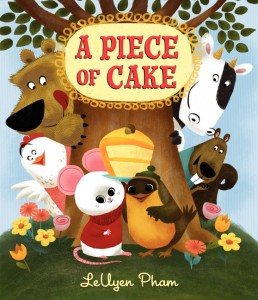 Every December I see lists of the best books of the year, and every year there’s at least one gem that I can’t believe isn’t getting more love. My choice this year for the “Don’t Miss This Picture Book” award is A Piece of Cake by LeUyen Pham (whose first name is pronounced “LeWin” but she mostly goes by “Win”. Now you know.)
Every December I see lists of the best books of the year, and every year there’s at least one gem that I can’t believe isn’t getting more love. My choice this year for the “Don’t Miss This Picture Book” award is A Piece of Cake by LeUyen Pham (whose first name is pronounced “LeWin” but she mostly goes by “Win”. Now you know.)
Pham had me from the moment she made the cover art reminiscent of a Golden Book, even down to her swirly signature. It starts like a sweet, simple story. A kind Mouse bakes a birthday cake for Little Bird, but then – there are all these unexpected surprises!
Mouse is bringing the cake to Little Bird’s house when Chicken stops him. Chicken wants a piece of cake, and the very kind Mouse has trouble saying no. Chicken, who is surrounded by eggs and is reading a book while sunning herself says, “If you give me a piece of that cake, I’ll trade you…” An egg, right? Nope! A cork, from Chicken’s bottle of suntan lotion.
At each stop on Mouse’s walk to and from Little Bird’s house, Pham sets us up to call out an obvious answer and then she delivers a twist that gets readers giggling. It reminds me of Guess Again by Mac Barnett and Adam Rex, but A Piece of Cake has a strong plot and internal logic as well as silly surprises. The cork that Chicken gave is used later for another unexpected purpose. It’s the ideal picture book to work on prediction and comprehension (Key Ideas and Details, anyone?)
Read this book aloud for the sheer pleasure of it, and then for the second reading, make a chart where kids can write what they thought would happen and what actually happened. “I thought Chicken would give Mouse ____ but then Chicken gave Mouse _________.” This is also a great story to act out for the whole group and then in centers so students can see what happens with each object. Make a Storybox with the characters and objects from the story for students to retell, and building comprehension skills will be A Piece of Cake.
Read More




